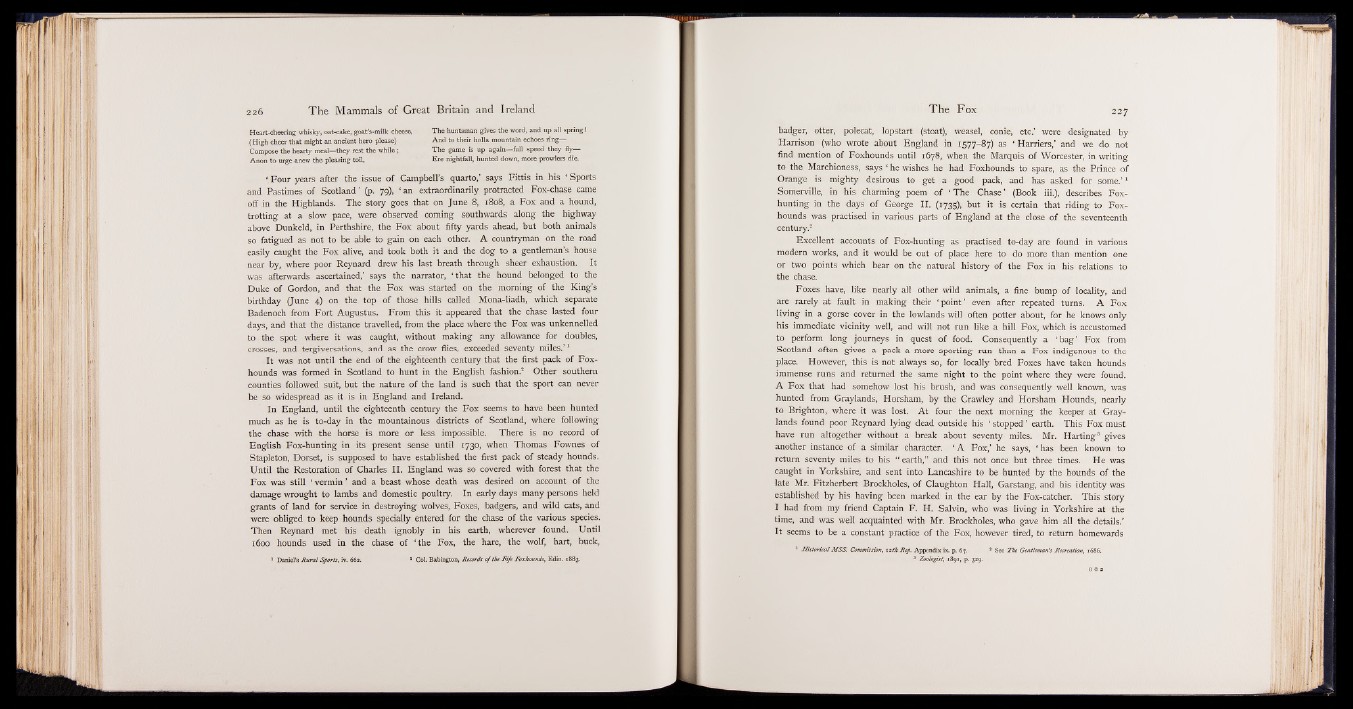
Heart-cheering whisky, oat-cake, goafs-milk cheese,
.(High cheer that might an ancient hero please)
Compose the hearty meal— they rest the while;
Anon to urge anew the pleasing toil,
The huntsman gives the word, and up all spring!
And to their holla mountain echoes ring—
The game is up again— full speed they fly—
Ere nightfall, hunted down, more prowlers die.
* Four years after the issue of Campbell’s quarto,’ says Fittis in his ‘ Sports
and Pastimes of Scotland’ (p. 79), ‘ an extraordinarily protracted Fox-chase came
off in the Highlands. The story goes that on June 8, 1808, a Fox and a hound,
trotting at a slow pace, were observed coming southwards along the highway
above Dunkeld, in Perthshire, the Fox about fifty yards ahead, but both animals
so fatigued as not to be able to gain on each other. A countryman on the road
easily caught the Fox alive, and took both it and the dog to a gentleman’s house
near by, where poor Reynard drew his last breath through sheer exhaustion. It
was afterwards ascertained,’ says the narrator, ‘ that the hound belonged to the
Duke of Gordon, and that the Fox was started on the morning of the King’s
birthday (June 4) on the top of those hills called Mona-liadh, which separate
Badenoch from Fort Augustus. From this it appeared that the chase lasted four
days, and that the distance travelled, from the place where the Fox was unkennelled
to the spot where it was caught, without making any allowance for doubles,
crosses, and tergiversations, and as the crow flies, exceeded seventy miles.’ 1
It was not until the end of the eighteenth century that the first pack of Foxhounds
was formed in Scotland to hunt in the English fashion.2 Other southern
counties followed suit, but the nature of the land is such that the sport can never
be so widespread as it is in England and Ireland.
In England, until the eighteenth century the Fox seems to have been hunted
much as he is to-day in the mountainous districts of Scotland, where following
the chase with the horse is more or less impossible. There is no record of
English Fox-hunting in its present sense until 1730, when Thomas Fownes of
Stapleton, Dorset, is supposed to have established the first pack of steady hounds.
Until the Restoration of Charles II. England was so covered with forest that the
Fox was still ‘ vermin ’ and a beast whose death was desired on account of the
damage wrought to lambs and domestic poultry. In early days many persons held
grants of land for service in destroying wolves, Foxes, badgers, and wild cats, and
were obliged to keep hounds specially entered for the chase of the various species.
Then Reynard met his death ignobly in his earth, wherever found. Until
1600 hounds used in the chase of ‘ the Fox, the hare, the wolf, hart, buck,
Daniel’s Rural Sports, iv. 662. * Col. Babington, Records o f the Fife Foxhounds, Edin. 1883.
badger, otter, polecat, lopstart (stoat), weasel, conie, etc.’ were designated by
Harrison (who wrote about England in 1577-87) as ‘ Harriers,’ and we do not
find mention of Foxhounds until 1678, when the Marquis of Worcester, in writing
to the Marchioness, says ‘ he wishes he had Foxhounds to spare, as the Prince of
Orange is mighty desirous to get a good pack, and has asked for some.’ 1
Somerville, in his charming poem of ‘ The Chase ’ (Book iii.); describes Foxhunting
in the days of George II. (1735)» but it is certain that riding to Foxhounds
was practised in various parts of England at the close of the seventeenth
century.2
Excellent accounts of Fox-hunting as practised to-day are found in various
modern works, and it would be out of place here to do more than mention one
or two points which bear on the natural history of the Fox in his relations to
the chase.
Foxes have, like nearly all other wild animals, a fine bump of locality, and
are rarely at fault in making their ‘ point’ even after repeated turns. A Fox
living in a gorse cover in the lowlands will often potter about, for he knows only
his immediate vicinity well, and will not run like a hill Fox, which is accustomed
to perform long journeys in quest of food. Consequently a ‘ bag’ Fox from
Scotland often gives a pack a more sporting run than a Fox indigenous to the
place. However, this is not always so, for locally bred Foxes have taken hounds
immense runs and returned the same night to the point where they were found.
A Fox that had somehow lost his brush, and was consequently well known, was
hunted from Graylands, Horsham, by the Crawley and Horsham Hounds, nearly
to Brighton, where it was lost. At four the next morning the keeper at Graylands
found poor Reynard lying dead outside his ‘ stopped ’ earth. This Fox must
have run altogether without a break about seventy miles. Mr. Harting8 gives
another instance of a similar character. ‘ A Fox,’ he says, ‘ has been known to
return seventy miles to his “ earth,” and this not once but three times. He was
caught in Yorkshire, and sent into Lancashire to be hunted by the hounds of the
late Mr. Fitzherbert Brockholes, of Claughton Hall, Garstang, and his identity was
established by his having been marked in the ear by the Fox-catcher. This story
I had from my friend Captain F. H. Salvin, who was living in Yorkshire at the
time, and was well acquainted with Mr. Brockholes, who gave him all the details.’
It seems to be a constant practice of the Fox, however tired, to return homewards
1 Historical MSS. Commission, 12th Rep. Appendix ix. p. 67.
2 See The Gentleman's Recreation, 1686.
3 Zoologisti 1891, p. 329.